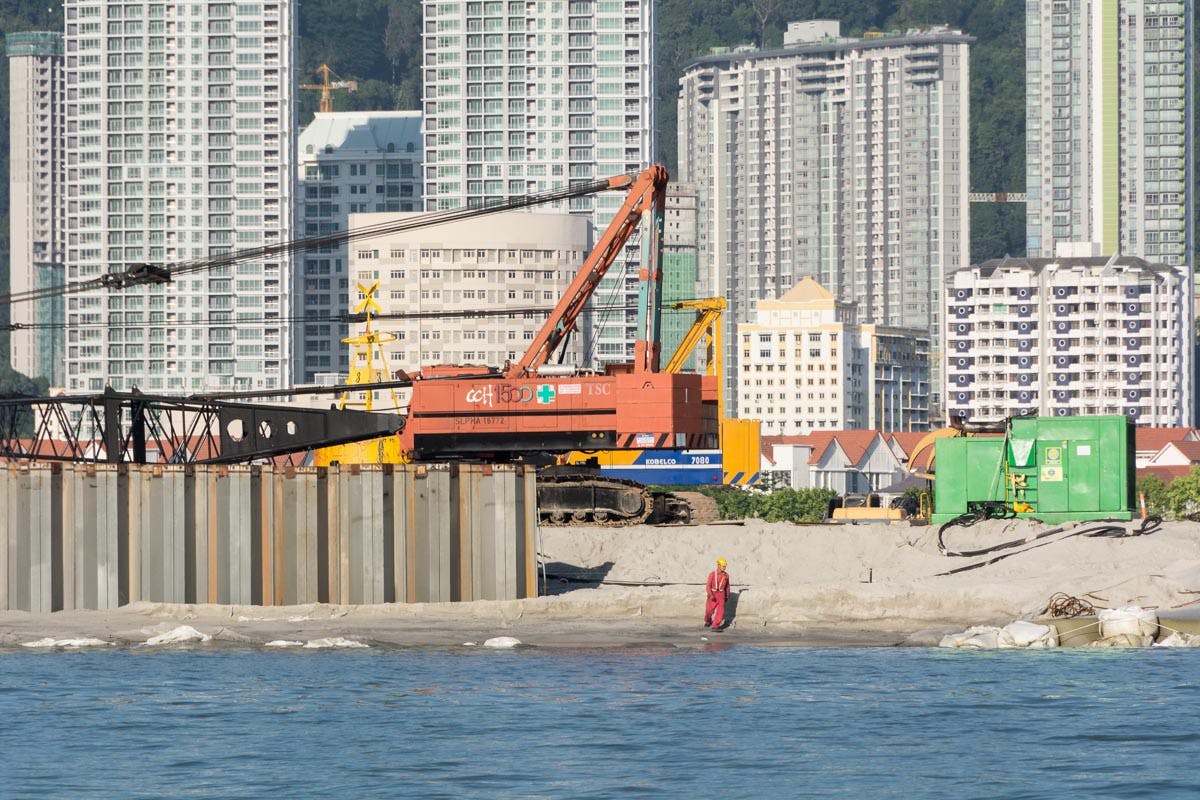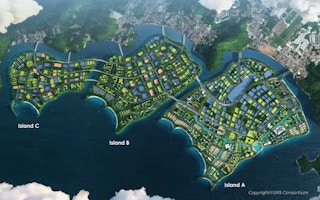An effort by the Malaysian government to further prop up the green credentials of a controversial mega reclamation project in Penang has been called out by environmentalists for greenwashing.
To continue reading, subscribe to Eco‑Business.
There's something for everyone. We offer a range of subscription plans.
- Access our stories and receive our Insights Weekly newsletter with the free EB Member plan.
- Unlock unlimited access to our content and archive with EB Circle.
- Publish your content with EB Premium.
The Penang South Islands project, which involves large-scale land reclamation for the development of a series of artificial islands spanning almost 17 square kilometres, was awarded a ‘low-carbon’ city award for its design last month by the Malaysian Green Technology Corporation (MGTC). A check with the government agency, which is under the country’s environment, energy and climate change ministry, however, confirms that for the project to receive the accolade, emissions associated with its development did not need to be considered. Instead, the award only focused on the planned design of the city.
“[The award] does not directly count and assess the environmental and social impacts [of the project],” MGTC told Eco-Business. Its assessment for giving the Penang South Islands project its Diamond Design Recognition only looked at five criteria: energy, water, waste, mobility and greenery, and how the project’s design integrated emissions reduction measures in these areas versus a business-as-usual scenario.
The Network for Ecology and Climate, a Penang-based non-profit, called the award “greenwashing at its best” and said that it ignores “the glaring fact” that the construction of the islands “can’t be possible without being fossil fuel-intensive and destroying the environment”. To build the proposed three new islands south of Penang’s main island, carbon-intensive land reclamation activities are required.
“Giving legitimacy to a project that comes with so many harmful consequences to the ecosystem and livelihoods, and exacerbates the impacts of climate change, sets a dangerous precedent,” it said in a tweet.
Khoo Salmah Nasution, a Penang-based spokesperson for the Malaysian Movement to Reject Reclamation, a non-governmental organisation, said that land reclamation for the Penang South Islands development could result in emissions of between 111 million kilogrammes of carbon dioxide and equivalent gases (kg CO2E) and 1.09 billion kg CO2E. The rough estimates take into account currently available information related to the dredging, transportation and deposit of sand required for the construction.
Based on an environmental impact assessment carried out in 2022, she estimates that about 207 million cubic metres of sand will be needed. An estimated 800 square kilometres of ocean bed – larger than the size of Singapore – will have to be dredged.
Academic research indicates that the range of emissions generated by land reclamation has varied from 0.54 kg CO2E to as high as 5.28 kg CO2E per square metre.

Reclamation activities are not new to Penang, with the Seri Tanjung Pinang project having been built on reclaimed land northeast of the island. Photo by Rod Harbinson/RodHarbinson.com via Mongabay.com
In addition to the emissions related to the transport of materials for reclamation, sand mining from the ocean floor can also release toxic metals and release other greenhouse gases such as methane and nitrous oxide, said Salmah, pointing to existing research on the impacts of reclamation. “Furthermore, the noise and vibration caused by sand mining equipment can disrupt marine life, affecting their behaviour and even leading to physical harm.”
Critics also point to how the environmental impact assessment (EIA) for the Penang South Islands project has yet to be approved by Malaysia’s Department of Environment. It was first submitted in 2019 and rejected, with the most recent submission made in April 2022.
When asked to address this, chief executive officer of the Penang Infrastructure Corporation Dato’ Seri Farizan bin Darus clarified that the resubmission was due to a procedural technicality rather than non-compliance with EIA conditions. “The current submission has passed through several technical review sessions with the Department of Environment and no further issues were raised,” he told Eco-Business.
On 12 March, Malaysia’s environment minister Nik Nazmi Nik Ahmad told the media that the project would not receive special treatment even though it is being backed by the Penang state government. The planned development would only be approved if it meets the stringent requirements associated with the EIA, Nik Nazmi said.
The Penang South Islands project was introduced by the state government in 2015 as the intended funding module for the RM46 billion (US$10.42 billion) Penang Transport Master Plan, an integrated transportation strategy for the state that would include setting up new public transportation systems and improving accessibility. The plan has been criticised by Penang’s civil society organisations for being ‘bloated’, with various groups including the consumer’s association and public transport users association calling for an independent review. In particular, the organisations say that the focus should be on improving the state’s bus system first instead of building a new light rapid transit train system (LRT).
Potential emissions reductions
As the south islands project developer, the Penang Infrastructure Corporation has announced various measures to address both the environmental and social impacts of the reclamation project. Farizan says that the development was “master-planned as a low-carbon city of the future with extensive strategies to counter climate change challenges”.
Among key carbon-reducing features of the Penang South Islands’ design are the compulsory use of rooftop solar panels for all developments, island-wide electric vehicle charging hubs and electric-powered public transportation. Some 405 acres of the reclaimed land have also been reserved to create a network of public parks, water canals, floodplains and wetlands.
Of these, the transportation initiatives are expected to contribute the most towards lowering emissions compared to a business-as-usual scenario, Farizan said. A shift to 70 per cent of transportation being public versus 30 per cent private transportation would result in a 20.26 per cent reduction in carbon emissions. Meanwhile, energy initiatives are expected to contribute a 15.61 percent reduction in carbon, said Farizan.
The MGTC also projects the potential emission reduction of the project at 844,296 tonnes of carbon dioxide (tCO2) per year based on these initiatives. This is 45.47 per cent lower compared to its business-as-usual baseline of 1,922,931 tCO2 per year, which would not have factored in the renewable energy and energy efficiency-related measures.
The claims made by MGTC on the amount of carbon that will be reduced by the project need to be further examined, said Salmah.
“For example, the ‘low-carbon plan’ promises to plant 200,000 trees. However, this is far short of the 147 million trees required (based on one mature tree sequestering 48 pounds of carbon dioxide per year) to offset the 3.2 million tonnes of carbon emissions generated annually by the project, based on figures provided by the Malaysian Physical Planning Council in its 18-point advice in 2019,” she wrote in a recent op-ed.
Salmah added that the proposed reclamation is located in a ‘greenfield’ site, making its carbon footprint vastly greater than projects that are located in brownfield areas, which had been previously developed or affected by development. On top of that, the reclamation site is an environmentally sensitive area where fish landings total 24.5 per cent of the state’s overall landings (13,418 tonnes per year), she wrote.

Locals in Penang have long protested the development of the Penang South Islands project, citing its environmental and social impacts. Image: Penang Tolak Tambak/ Facebook
On the environmental front, the Penang Infrastructure Corporation has in place an ecology offset master plan as part of the islands’ development, which aims to provide coastal protection, carbon sequestration, and new habitats for marine life. This includes planting mangroves at locations advised by the Forestry Department, an activity which is already underway, and releasing juvenile fish and prawns, also known as fries.
Other measures include deploying artificial reefs near Pulau Kendi, a small uninhabited island off of Penang’s coast, and using fish aggregating devices, although international research has suggested that such initiatives may sometimes do more harm than good to the marine ecosystem. However, Farizan said that the developer has appointed Universiti Sains Malaysia’s Centre of Marine and Coastal Studies to conduct studies on artificial reefs and the release of fish and prawn fries. “They will identify the best locations for these programmes and the Department of Fisheries will be consulted,” Farizan shared.
Affected fisheries
The Penang Infrastructure Corporation will also build ‘eco-shorelines’, concrete sea walls designed to protect marine life, along the perimeter of the reclaimed islands, establish “green river” programmes and establish funds for marine ecology, he said.
Opinion, however, is divided as to what reparations should be made to the fisheries industry, which includes thousands of fishermen affected by the planned construction of the south islands. The Penang Infrastructure Corporation, as part of its social impact management plan for the project, has made offers to the local fishing community affected by the development. These include financial aid, plans for new infrastructure, training and education opportunities, and home ownership schemes.
The Penang Fishermen’s Association, however, has continued to protest the development, saying that the proposed RM20,000 (US$4,524) compensation is too little and inconsistent. Members of the association said that they will reject any offer being made by the project’s developers as compensation.
Farizan told Eco-Business that the Penang Infrastructure Corporation will stand by the current scheme, which he says was drawn up with feedback from fishermen and related government agencies in 2020. “Many fishermen have signed up for it, and a number have already benefited from the boat and engine aid, the seafarers’ programme and RM500 advance ex-gratia payment.”
“No other reclamation project in the country has offered anything as comprehensive,” he added. “But if the fishermen association is interested to discuss the package and give its views, we will listen and consider what is reasonable. The state government is always open to discussions and we are prepared to continue engaging the project’s stakeholders throughout the project.”








